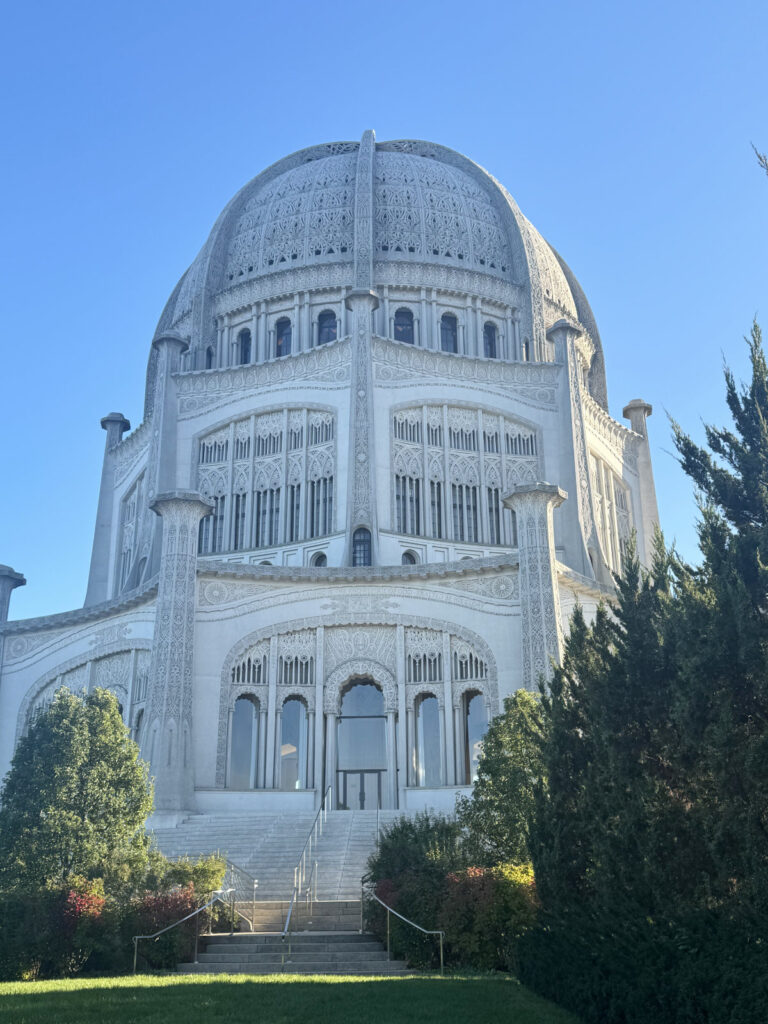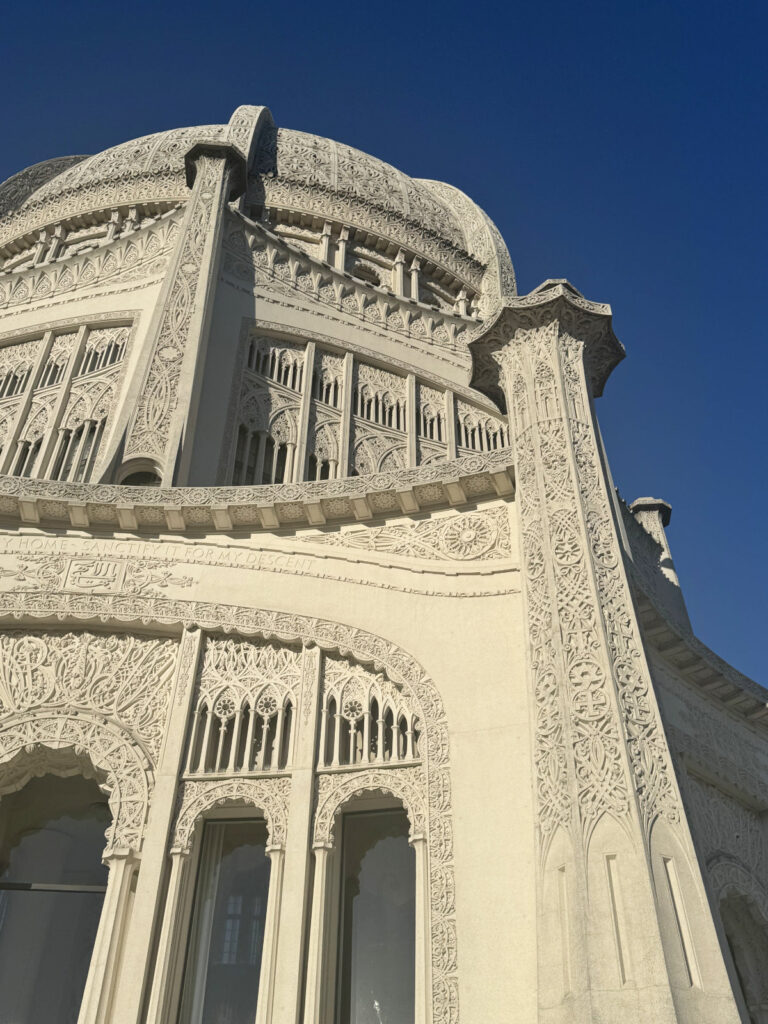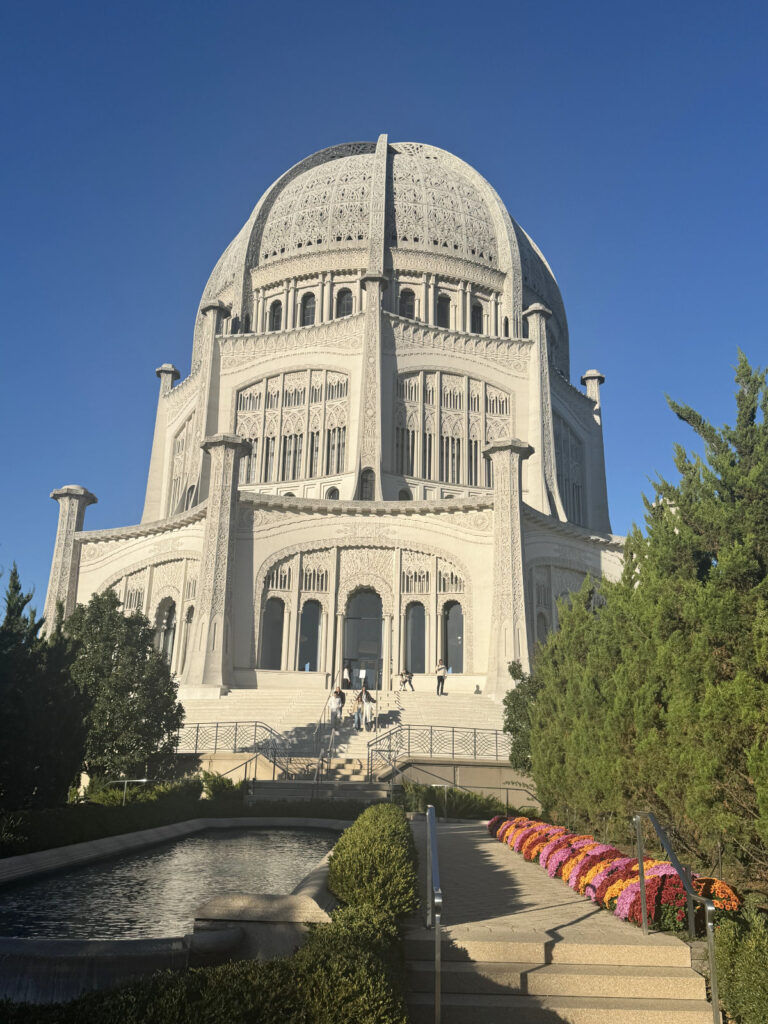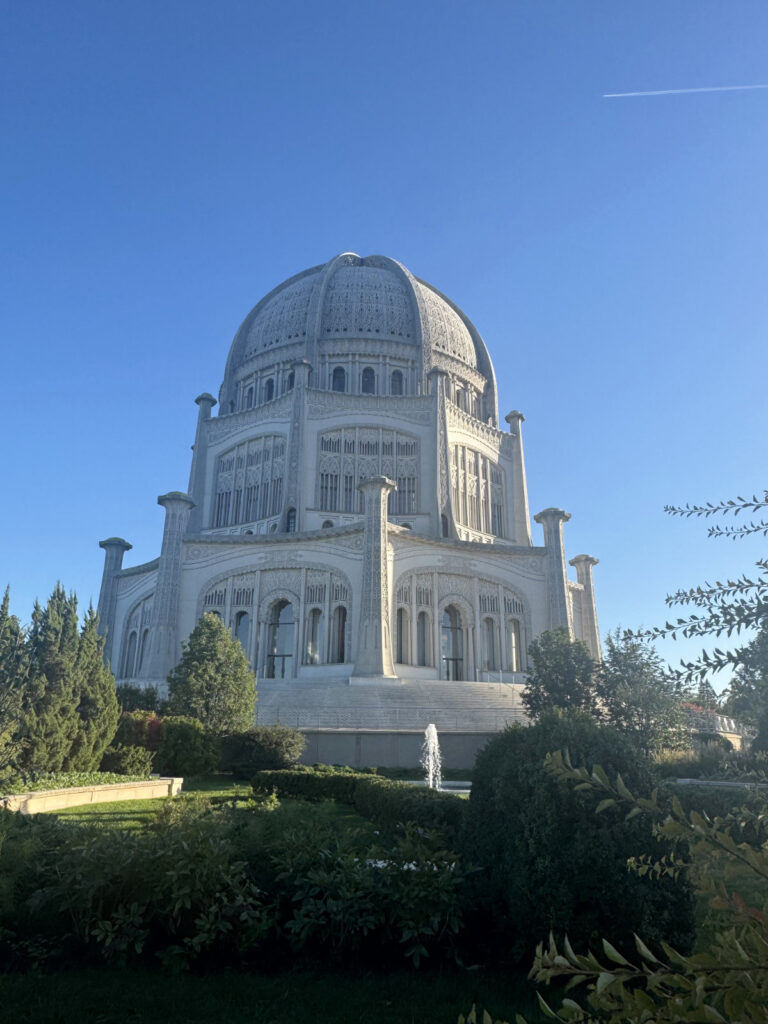Bahai House of Worship in Wilmette I have been visiting every summer season few times. For me it has become one of my favorite spots where where I can spend some quiet time and enjoy the peace. I would say kind of meditation place for me.
Overall, this place is very serene, featuring peaceful ambience. Believe me, if you’re ever craving a moment of stillness not far from the hum of Chicago, the Bahá’í House of Worship in Wilmette, Illinois offers just that a quiet sanctuary of light, stone, and spiritual possibility.
I have been visiting this place every year and thought of sharing it with my readers so that they know the delicate interplay of architecture, gardens, and inner calmness.

The Temple is Unlike Any Other
It is hard to miss when you are walking up Linden Avenue. Yes, you will catch your first glimpse of what almost seems like a lace-carved white shell rising above the trees.
That’s the temple’s outer structure, glowing softly in daylight. This temple features a nine-sided, domed edifice set amid nine gardens and nine fountains. It is a physical expression of a key Bahá’í principle: unity in diversity.
What strikes you immediately is how different it feels from a standard “church” or “temple” in the usual sense. There’s no ritual or ceremony required or even no pressure to belong. Temple doors are open daily to people of all faiths or none.

A Bit of History (Because I find it Fascinating)
I don’t normally geek out on timelines but reading provided flyer at the temple this one is worth it.
- The idea began in Chicago in 1903 when American Bahá’ís felt drawn to build a House of Worship in their country.
- In 1907 land was purchased in Wilmette, just north of Chicago on the lakeshore
- On May 1, 1912, ʻAbdu’l-Bahá , he was the son of the faith’s founder. He laid the temple’s cornerstone. He famously declined a fancy golden trowel and used the same spade as everyone else.
- But then things got slow global wars, the Great Depression, funding challenges. The project dragged on for decades.
- Finally, in 1953, over 5,000 people gathered as the House of Worship was dedicated.
What impresses me most is how the temple became in slow, steady faith and effort. It took over four decades to build.

Architecture as a Spiritual Conversation
One of the most beautiful things about the Wilmette temple is how its design speaks both to faith and to art.
The Bahai House of Worship in Wilmette is designed by the architect Louis Bourgeois. You will be surprised to see that Bahai Temple features symbols of various faiths carved on the walls including the Star of David, the swastika and the symbol of Islam.
Also, construction includes number “nine”, yes it has nine entrances, nine alcoves, nine fountains in garden.
The moment you enter inside, you will be stunned with the interior as you will feel the calm and peaceful ambience. It is very serene and designed for prayer and chanting.

What It Feels Like Inside
When I walked into the sanctuary I remember stepping into a hush. The ambience is very peaceful and you will notice that inside sound carries, voices echo slightly.
Personally, I love spending good amount of time spending inside sitting in peaceful and serene ambience. I highly recommend that you must sit, absorb. Believe me, you can just be yourself. The fact I liked that I always feel like inside it feels like time pausing. And I feel that it is rare in our modern pace.
One thing I noticed (and a tip): photography is not allowed inside the main auditorium.
So I took photographs of exterior and wandered through the gardens. If you are into natural sounds then consider to sit by one of the fountains to enjoy the water sounds in garden.
Why Not to Ignore Gardens, Light, and the Surrounding Peace
Outside, the Bahai House of Worship in Wilmette temple is embraced by nine formal gardens, fountains, and pathways. I had great time walking slowly, almost meditation-walk.
If you time it right in the morning or late afternoon then you might get lucky to see the white stone glow.
Trust me, the place is very beautiful and serene.
What You Should Know Before Visit
Here are some practical (and personal) notes from my visit:
- Hours: Place is open daily from dawn to dusk (6:00 a.m. to 6:00 p.m.
- If you are looking to get more information about the temple then you can visit the Welcome Center, located just west of the Temple along Linden Avenue.
- They often hold devotional services (open to the public) Wednesday through Sunday at 12:30 pm and 6:00 pm.
- There is no admission fee
- I highly suggest that you must dress modestly with shoes. Photography is fine outside, but not allowed inside the auditorium.
- Getting there is relatively straightforward: from Chicago, you can take public transit. You can take Red Line upto Howard and then switch to Purple Line to get off at Linden station. From the station you walk a few blocks.
- One tip I’d pass along: if possible then go early on a weekday if you can. Fewer visitors, more silence. More space for your own breathing.
Overall, place is peaceful and serene. Whenever I step away from places like this, I always feel a little reset. The world suddenly seems bigger, calmer, more interconnected.
So whether you’re someone exploring architecture, someone curious about faith, or someone just chasing peace for an afternoon then the Bahá’í House of Worship in Wilmette is worth the trip.
I INSIST when you go there I hope you’ll let yourself simply be for a bit.
 Go Visit Chicago Let's Discover the Windy City
Go Visit Chicago Let's Discover the Windy City


